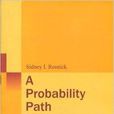《機率論入門(英文)》中附了豐富的參考資料和詳細的術語表,使得《機率論入門(英文)》的可讀性更加增大。《機率論入門(英文)》的重點講述大量的技巧和觀點,包括了深層次學習本科目的必備的核心知識,這些可以使學生能夠學習特殊動力系統並獲得學習這些系統大量信息。
基本介紹
- 書名:機率論入門
- 作者:雷斯尼克 (Sidney I.Resnick)
- 出版日期:2013年3月1日
- 語種:簡體中文, 英語
- ISBN:9787510058271
- 外文名:A Probabiltiy Path
- 出版社:世界圖書出版公司北京公司
- 頁數:435頁
- 開本:24
- 品牌:世界圖書出版公司北京公司
基本介紹
內容簡介
作者簡介
圖書目錄
1 Sets and Eyents
1.1 Introduction
1.2 BasicSetTheory
1.2.1 Indicatotfunotions
1.3 LimitsofSets
1.4 MonotoneSequences
1.5 SetOperations andClosure
1.5.1 Examples
1.6 The σ-field Generated by a Given Class C
1.7 Borel Sets on the Real Line
1.8 Comparing Borel Sets
1.9 Exeroises.
2 Probability Spaces
2.1 Basic Definitions and Properties
2.2 More onClosure
2.2.1 Dynkin'Stheorem
2.2.2 Proof of Dynkin'Stheorem
2.3 Two Constructions
2.4 Constructions of Probability Spaces
2.4.1 GeneraI Construction of a Probability Model
2.4.2 Proof of the Second Extension Theorem
2.5 Measure Constructions
2.5.1 Lebesgue Measure on(0,1]
2.5.2 Construction of a Probability Measure on R with Given
DistributionFunction F(x)
2.6 Exercises
3 Random variables,Elements,and Measurable Maps
3.1 Inverse Maps
3.2 Measurable Malas,Random Elements
Induced Probability Measnres
3.2.1 Composition
3.2.2 Random Elements of Metric Spaces
3.2.3 Measurability andContinuity
3.2.4 Measurabilitv andLimits
3.3 σ-FieldsGenerated byMaps
3.4 Exercises
4 Independence
4.1 Basic Definitions
4.2 Independent Random Variables
4.3 Two Examples ofIndependence
4.3.1 Records,Ranks,RenyiTheorem.
4.3.2 Dyadic Expansions of Uniforill Random Numbers.
4.4 More onIndependence:Groupings
4.5 Independence,Zero-One Laws,Borel-Cantelli Lemma.
4.5.1 Borel-CantelliLemma
4.5.2 Borel Zero-OneLaw
4.5.3 Kolmogorov Zero-One Law
4.6 Exercises
5 Integration and Expectation
5.1 Preparation for Integration
5.1.1 Simple Functions
5.1.2 Measurability and Simple Functions
5.2 Expectation andIntegration
5.2.1 Expectation of Simple Functions
5.2.2 Extension of the Definition
5.2.3 Basic Properties of Expectation
5.3 Limits and Integrals
5.4 Indefinite Integrals
5.5 The Transformation Theorem and Densities
5.5.1 Expectation is Always anIntegral on R
5.5.2 Densities
5.6 The Riemann vs Lebesgue Integral
5.7 Product Spaces
5.8 Probabifity Measureson Product Spaces
5.9 Fubini's theorem
5.10 Exercises
6 Convergence Concepts
6.1 Almost Sur eConvergence
6.2 Convergence in Probability
6.2.1 Statisticsl Terminology
6.3 Connections Between a.a.and i.p.Convergence
6.4 0uantile Estimation
6.5 Lp Convergence
6.5.1 Uniform Integrability
6.5.2 Interlude:A Review of Inequalities
6.6 More on Lp Convergence
6.7 Exercises
7 Laws of Large Numbers and Sums
of Independent Random Variables
7.1 Truncation and Equivalence
7.2 A General Weak Law of Large Numbers
7.3 Almost Sure Convergence of Sums
of Independent Random Variables
7.4 Strong Lawsof Large Numbers
7.4.1 Two Examples
7.5 The Strong Lawof Large Numbers for IID Sequences
7.5.1 Two Applications of the SLLN
7.6 The Kolmogorov Three Series Theorem
7.6.1 Necessity of the Kolmogorov Three Series Theorem
7.7 Exercises
8 Convergence in Distribution
8.1 Basic Definitions
8.2 Schefe's lemma
8.2.1 Scheffe's Lemma and Order Statistics
8.3 The Baby Skorohod Theorem
8.3.1 The Delta Method
8.4 Weak Convergence Equivalences;Portmanteau Theorem
8.5 More Relations Among Modes ofConvergence
8.6 New Convergencesfrom Old
8.6.1 Example:The Central Limit Ineorem for m-Dependent
Random variables
8.7 The Convergence to Types Theorem
8.7.1 Applicationof Convergenceto Types:Limit Distributions
for Extremes
8.8 Exercises
9 Characteristic Functions and the Central Limit Theorem
9.1 Review of Moment Generating Functions
and the Central Limit Theorcm
9.2 Characteristic Functions:Definition and First Properties
9.3 Expansions
9.3.1 Expansion ofe ix
9.4 Momelts and Derivatives
9.5 Two Big Theorems:Uniqueness and Continuity
9.6 The Selection Theorem,Tightness,and
Prohorov's theorem
9.6.1 The Selection Theorem
9.6.2 Tightness,Relative Compactness,
and Prohorov's Theorem
9.6.3 Proof of the Continuity Theorem
9.7 The Classical CLT for iid Random Variables
9.8 The Lindeberg-Feller CLT
9.9 Exercises
10 Martingales
10.1 Prelude to Conditional Expectation:
The Radon-Nikodym Theorem
10.2 Definition of Cnnditional Expectation
10.3 Properties of ConditionaI Expectation
10.4 Martingales
10.5 Examples of Martingales.
10.6 Connections between Martingales and Submartingales
10.6.1 Doob's Decomposition
10.7 StoppingT imes
10.8 Positive Super Martingales
10.8.1 Operations on Supermartingales
10.8.2 Upcrossings
10.8.3 Bonndedness Properties
10.8.4 Convergence of Positive Super Martingales
10.8.5 CInsure
10.8.6 Stopping Supermartingales
10.9 Examples
10.9.1 Gambler's Ruin
10.9.2 Branching Processes
10.9.3 Some Differentiation Theory.
10.10 Martingale and Submartingale Convergence
10.10.1 Krickeberg Decomposition
10.10.2 Doob's(Sub)martingale Convergence Theorem
10.11 Regularity and Clnsure
10.12 Regularity and Stopping
10.13 Stopping Theorems
10.14 Wald's Identity and RandomWalks
10.14.1 The Basic Martingales
10.14.2 Regular Stopping Times
10.14.3 Examples of Integrable Stopping Times
10.14.4 The Simple Random Walk
10.15 Reversed Martingales
10.16 Fundamental Theorems of Mathematical Finance
10.16.1 ASimple Market Model
10.16.2 Admissible Strategies and Arbitrage
10.16.3 Arbitrage and Martingales
10.16.4 Complete Markets
10.16.5 Option Pricing
10.17 Exereises
RefeFences
Index

